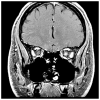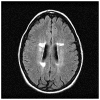Optic neuritis
Abstract
Demyelinating optic neuritis is the most common cause of unilateral painful visual loss in the United States. Although patients presenting with demyelinating optic neuritis have favorable long-term visual prognosis, optic neuritis is the initial clinical manifestation of multiple sclerosis in 20% of patients. The Optic Neuritis Treatment Trial (ONTT) has helped stratify the risk of developing multiple sclerosis after the first episode of optic neuritis based on abnormal findings on brain MRI. The ONTT also demonstrated that while initial treatment of optic neuritis with intravenous corticosteroids followed by an oral taper accelerates visual recovery, its use does not improve long-term visual outcomes. Long-term treatment with immunomodulating agents such as interferons has been shown to improve clinical outcomes and neuroimaging abnormalities in multiple sclerosis; furthermore interferon use has been associated with decreased risk of subsequent multiple sclerosis in patients with an acute neurologic syndrome. However, several questions regarding the presentation, management, and implications of acute demyelinating optic neuritis remain unanswered.
Keywords: Demyelinating Diseases; Optic Nerve Diseases; Optic Neuritis.
Figures





References
-
- Shams PN, Plant GT. Optic neuritis: a review. Int MS J. 2009;16:82–89. - PubMed
-
- Bertuzzi F, Suzani M, Tagliabue E, Cavaletti G, Angeli R, Balgera R, et al. Diagnostic validity of optic disc and retinal nerve fiber layer evaluations in detecting structural changes after optic neuritis. Ophthalmology. 2010;117:1256–1264.e1. - PubMed
-
- Balcer LJ. Clinical practice. Optic neuritis. N Engl J Med. 2006;354:1273–1280. - PubMed
-
- Brady KM, Brar AS, Lee AG, Coats DK, Paysse EA, Steinkuller PG. Optic neuritis in children: clinical features and visual outcome. J AAPOS. 1999;3:98–103. - PubMed
LinkOut - more resources
Full Text Sources
